Challenges Faced in Managing Asthma in Elderly Patients: A Study
VerifiedAdded on 2023/03/23
|73
|19645
|20
Report
AI Summary
This report presents a systematic literature review focusing on the challenges encountered in managing asthma in elderly patients. The review, conducted by Minil Thomas, examines the impact of comorbidities, medication adherence, and under-diagnosis on asthma management in older adults. The study analyzed 11 articles from databases like PubMed and Medline, identifying themes related to treatment challenges, medication compliance, and diagnostic difficulties. The research question addressed is: "What challenges can affect interventions for better progress in asthma symptoms for elderly asthma patients?" The findings highlight the influence of factors like poor medication adherence, overlapping symptoms, co-morbidities, lack of health literacy, and depression on exacerbation of asthma symptoms and the quality of life for older adults. The report also explores the aim, objectives, methodology, and implications for clinical practice, offering recommendations to improve asthma management for the elderly population. The study concludes with a call for further research to address gaps in current knowledge and improve the standard of care.
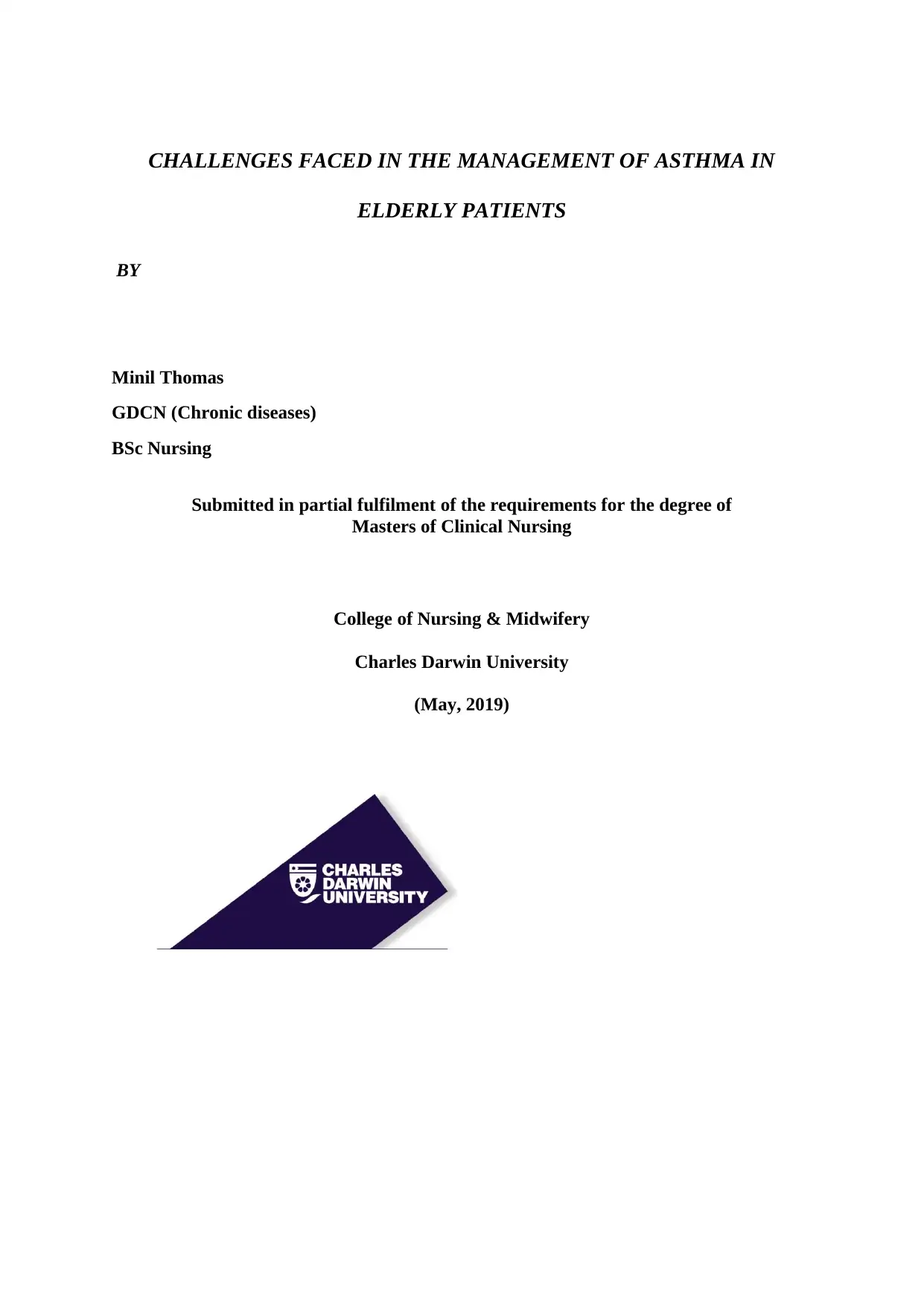
CHALLENGES FACED IN THE MANAGEMENT OF ASTHMA IN
ELDERLY PATIENTS
BY
Minil Thomas
GDCN (Chronic diseases)
BSc Nursing
Submitted in partial fulfilment of the requirements for the degree of
Masters of Clinical Nursing
College of Nursing & Midwifery
Charles Darwin University
(May, 2019)
ELDERLY PATIENTS
BY
Minil Thomas
GDCN (Chronic diseases)
BSc Nursing
Submitted in partial fulfilment of the requirements for the degree of
Masters of Clinical Nursing
College of Nursing & Midwifery
Charles Darwin University
(May, 2019)
Paraphrase This Document
Need a fresh take? Get an instant paraphrase of this document with our AI Paraphraser
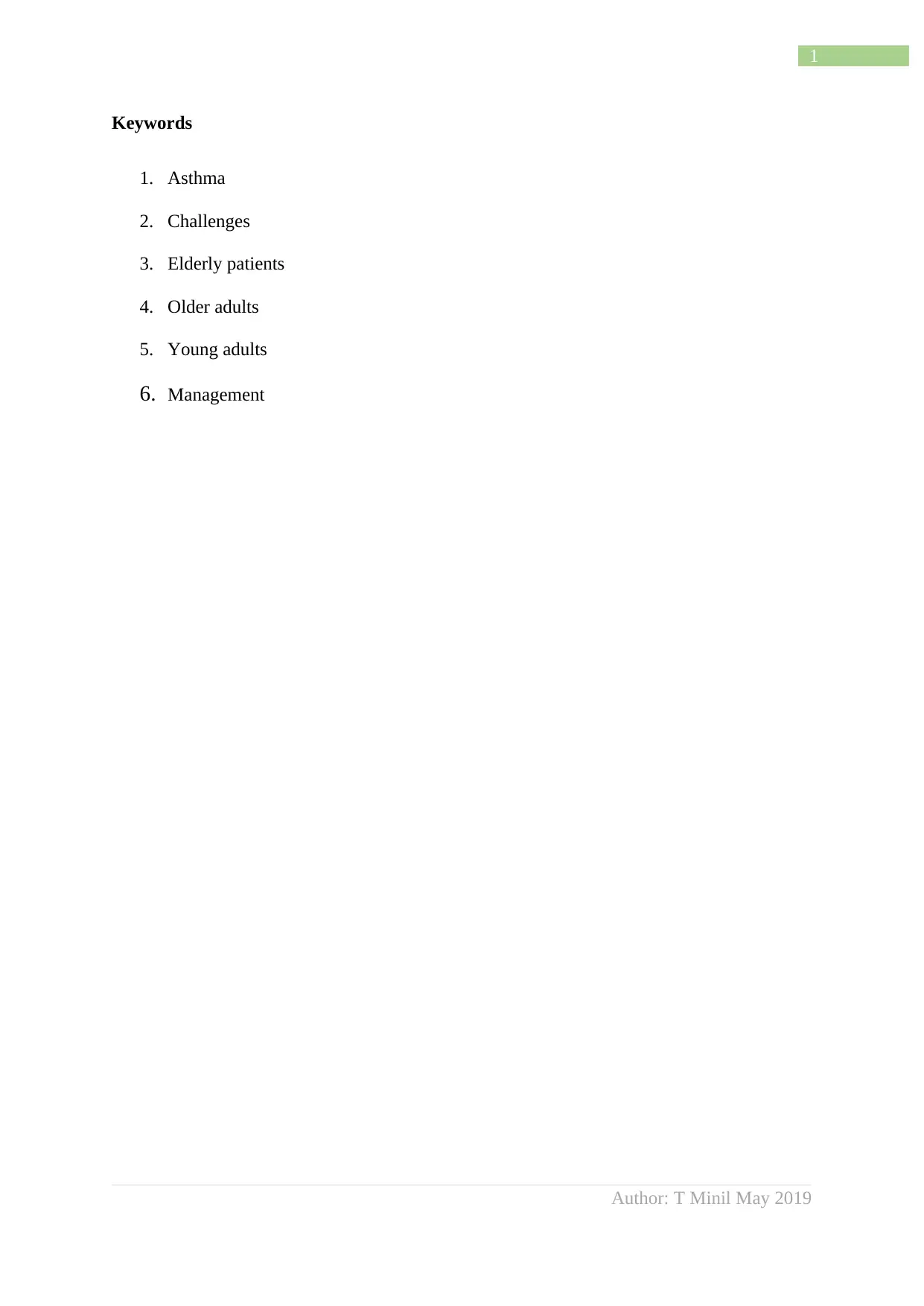
1
Keywords
1. Asthma
2. Challenges
3. Elderly patients
4. Older adults
5. Young adults
6. Management
Author: T Minil May 2019
Keywords
1. Asthma
2. Challenges
3. Elderly patients
4. Older adults
5. Young adults
6. Management
Author: T Minil May 2019
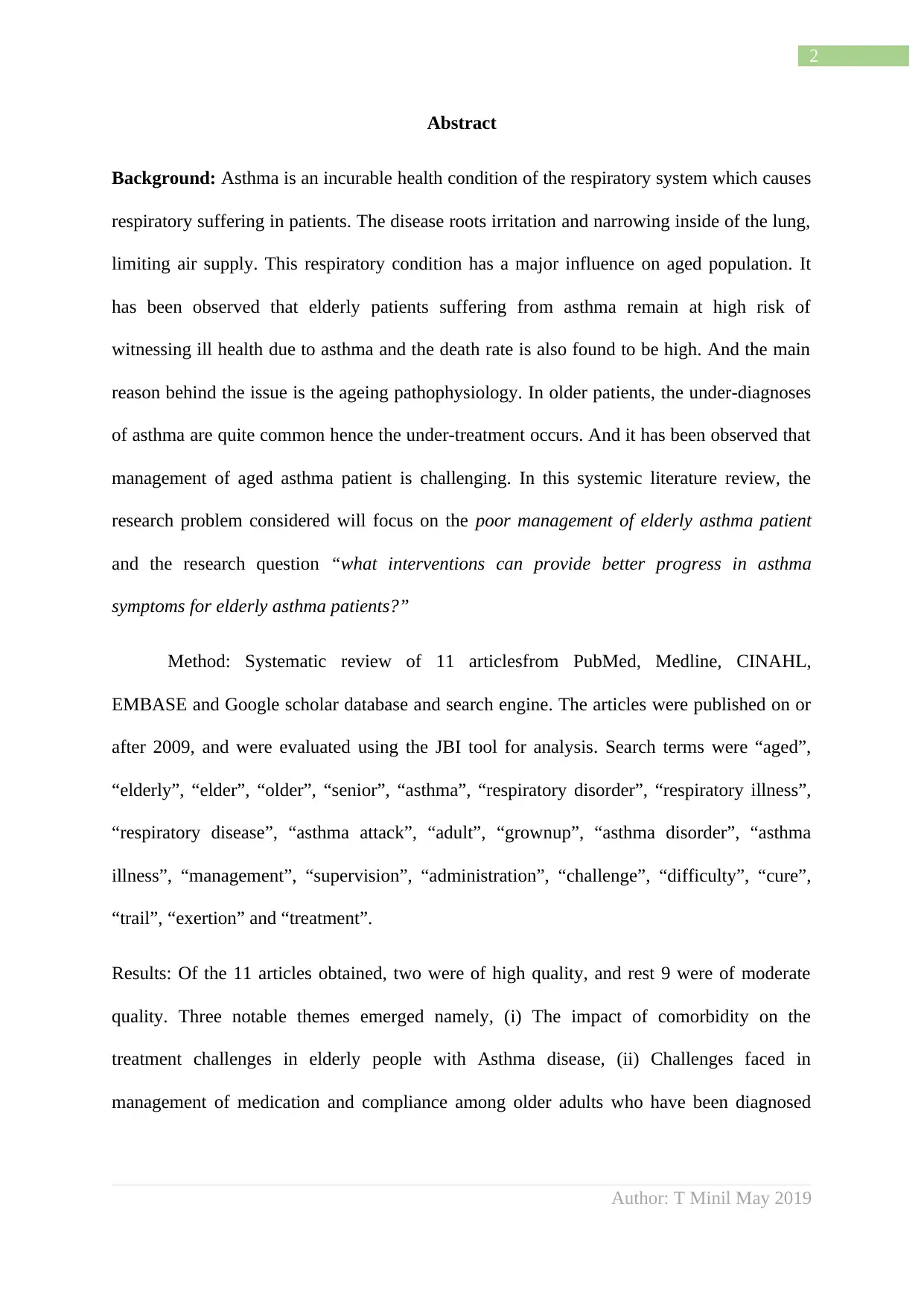
2
Abstract
Background: Asthma is an incurable health condition of the respiratory system which causes
respiratory suffering in patients. The disease roots irritation and narrowing inside of the lung,
limiting air supply. This respiratory condition has a major influence on aged population. It
has been observed that elderly patients suffering from asthma remain at high risk of
witnessing ill health due to asthma and the death rate is also found to be high. And the main
reason behind the issue is the ageing pathophysiology. In older patients, the under-diagnoses
of asthma are quite common hence the under-treatment occurs. And it has been observed that
management of aged asthma patient is challenging. In this systemic literature review, the
research problem considered will focus on the poor management of elderly asthma patient
and the research question “what interventions can provide better progress in asthma
symptoms for elderly asthma patients?”
Method: Systematic review of 11 articlesfrom PubMed, Medline, CINAHL,
EMBASE and Google scholar database and search engine. The articles were published on or
after 2009, and were evaluated using the JBI tool for analysis. Search terms were “aged”,
“elderly”, “elder”, “older”, “senior”, “asthma”, “respiratory disorder”, “respiratory illness”,
“respiratory disease”, “asthma attack”, “adult”, “grownup”, “asthma disorder”, “asthma
illness”, “management”, “supervision”, “administration”, “challenge”, “difficulty”, “cure”,
“trail”, “exertion” and “treatment”.
Results: Of the 11 articles obtained, two were of high quality, and rest 9 were of moderate
quality. Three notable themes emerged namely, (i) The impact of comorbidity on the
treatment challenges in elderly people with Asthma disease, (ii) Challenges faced in
management of medication and compliance among older adults who have been diagnosed
Author: T Minil May 2019
Abstract
Background: Asthma is an incurable health condition of the respiratory system which causes
respiratory suffering in patients. The disease roots irritation and narrowing inside of the lung,
limiting air supply. This respiratory condition has a major influence on aged population. It
has been observed that elderly patients suffering from asthma remain at high risk of
witnessing ill health due to asthma and the death rate is also found to be high. And the main
reason behind the issue is the ageing pathophysiology. In older patients, the under-diagnoses
of asthma are quite common hence the under-treatment occurs. And it has been observed that
management of aged asthma patient is challenging. In this systemic literature review, the
research problem considered will focus on the poor management of elderly asthma patient
and the research question “what interventions can provide better progress in asthma
symptoms for elderly asthma patients?”
Method: Systematic review of 11 articlesfrom PubMed, Medline, CINAHL,
EMBASE and Google scholar database and search engine. The articles were published on or
after 2009, and were evaluated using the JBI tool for analysis. Search terms were “aged”,
“elderly”, “elder”, “older”, “senior”, “asthma”, “respiratory disorder”, “respiratory illness”,
“respiratory disease”, “asthma attack”, “adult”, “grownup”, “asthma disorder”, “asthma
illness”, “management”, “supervision”, “administration”, “challenge”, “difficulty”, “cure”,
“trail”, “exertion” and “treatment”.
Results: Of the 11 articles obtained, two were of high quality, and rest 9 were of moderate
quality. Three notable themes emerged namely, (i) The impact of comorbidity on the
treatment challenges in elderly people with Asthma disease, (ii) Challenges faced in
management of medication and compliance among older adults who have been diagnosed
Author: T Minil May 2019
⊘ This is a preview!⊘
Do you want full access?
Subscribe today to unlock all pages.

Trusted by 1+ million students worldwide
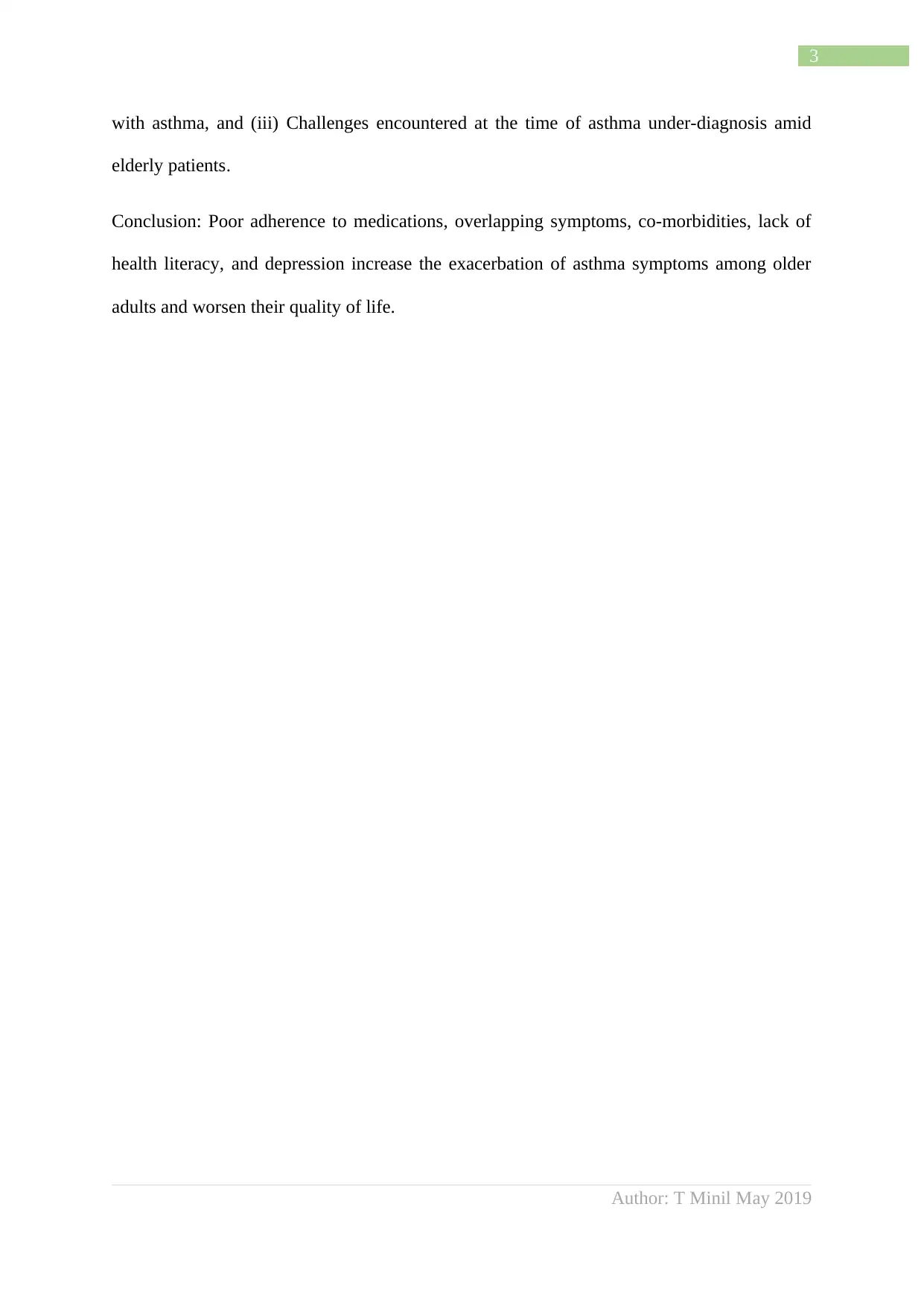
3
with asthma, and (iii) Challenges encountered at the time of asthma under-diagnosis amid
elderly patients.
Conclusion: Poor adherence to medications, overlapping symptoms, co-morbidities, lack of
health literacy, and depression increase the exacerbation of asthma symptoms among older
adults and worsen their quality of life.
Author: T Minil May 2019
with asthma, and (iii) Challenges encountered at the time of asthma under-diagnosis amid
elderly patients.
Conclusion: Poor adherence to medications, overlapping symptoms, co-morbidities, lack of
health literacy, and depression increase the exacerbation of asthma symptoms among older
adults and worsen their quality of life.
Author: T Minil May 2019
Paraphrase This Document
Need a fresh take? Get an instant paraphrase of this document with our AI Paraphraser

4
Table of Contents
List of figures.............................................................................................................................5
List of tables...............................................................................................................................6
List of appendices......................................................................................................................7
Statement of original authorship................................................................................................8
Acknowledgements....................................................................................................................9
Introduction..............................................................................................................................10
Aim:......................................................................................................................................12
Objective:.............................................................................................................................12
Research question:...............................................................................................................12
Pico Framework...................................................................................................................12
Methodology:...........................................................................................................................15
Standards for including the studies:.....................................................................................15
Identification of studies:.......................................................................................................16
Result:......................................................................................................................................18
The impact of co-morbidity on the treatment challenges in elderly people with Asthma
disease:.................................................................................................................................18
Challenges faced in management of medication and compliance among older adults who
have been diagnosed with asthma........................................................................................22
Challenges encountered at the time of asthma under-diagnosis amid elderly patients........25
Discussion................................................................................................................................28
Author: T Minil May 2019
Table of Contents
List of figures.............................................................................................................................5
List of tables...............................................................................................................................6
List of appendices......................................................................................................................7
Statement of original authorship................................................................................................8
Acknowledgements....................................................................................................................9
Introduction..............................................................................................................................10
Aim:......................................................................................................................................12
Objective:.............................................................................................................................12
Research question:...............................................................................................................12
Pico Framework...................................................................................................................12
Methodology:...........................................................................................................................15
Standards for including the studies:.....................................................................................15
Identification of studies:.......................................................................................................16
Result:......................................................................................................................................18
The impact of co-morbidity on the treatment challenges in elderly people with Asthma
disease:.................................................................................................................................18
Challenges faced in management of medication and compliance among older adults who
have been diagnosed with asthma........................................................................................22
Challenges encountered at the time of asthma under-diagnosis amid elderly patients........25
Discussion................................................................................................................................28
Author: T Minil May 2019
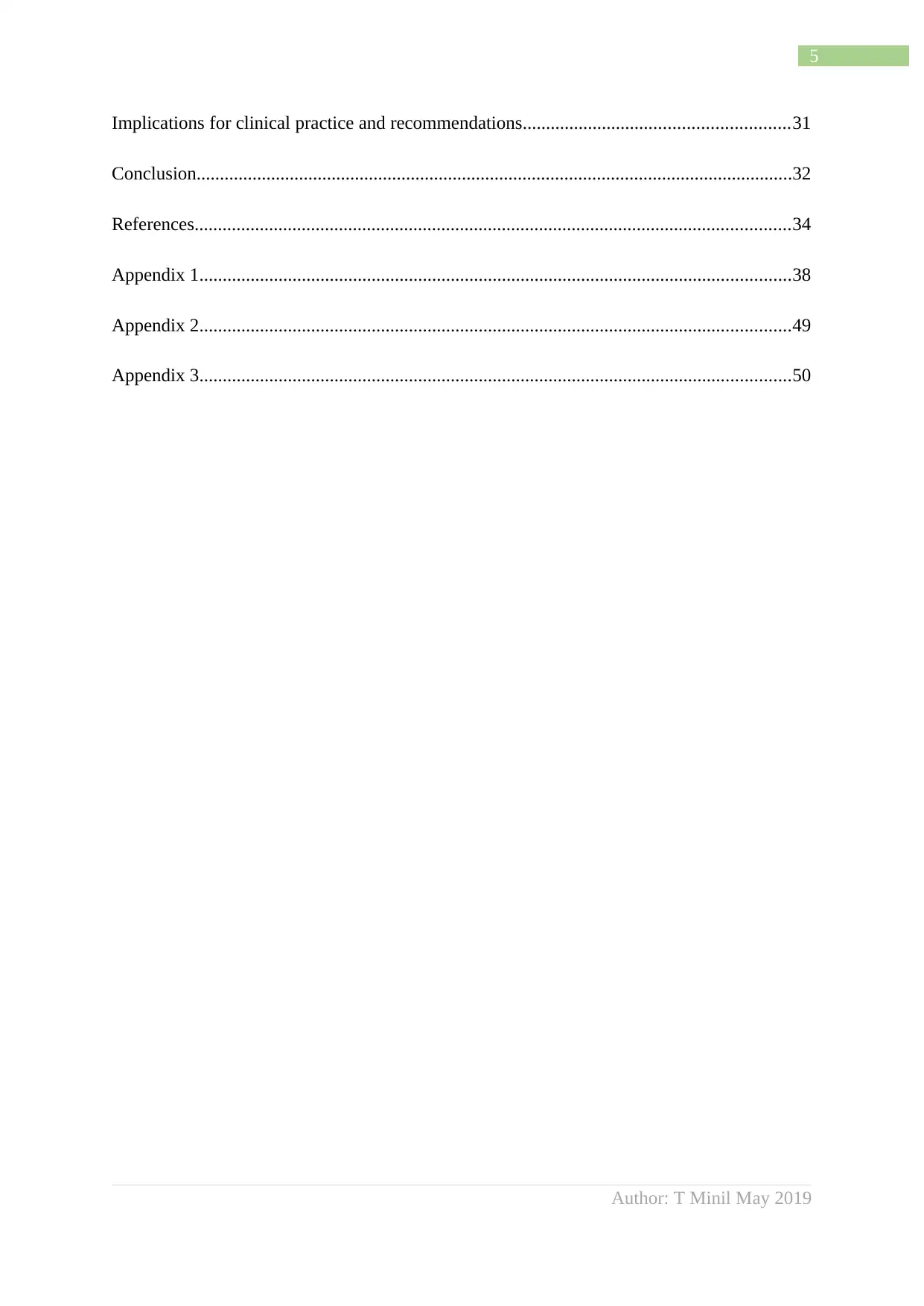
5
Implications for clinical practice and recommendations.........................................................31
Conclusion................................................................................................................................32
References................................................................................................................................34
Appendix 1...............................................................................................................................38
Appendix 2...............................................................................................................................49
Appendix 3...............................................................................................................................50
Author: T Minil May 2019
Implications for clinical practice and recommendations.........................................................31
Conclusion................................................................................................................................32
References................................................................................................................................34
Appendix 1...............................................................................................................................38
Appendix 2...............................................................................................................................49
Appendix 3...............................................................................................................................50
Author: T Minil May 2019
⊘ This is a preview!⊘
Do you want full access?
Subscribe today to unlock all pages.

Trusted by 1+ million students worldwide
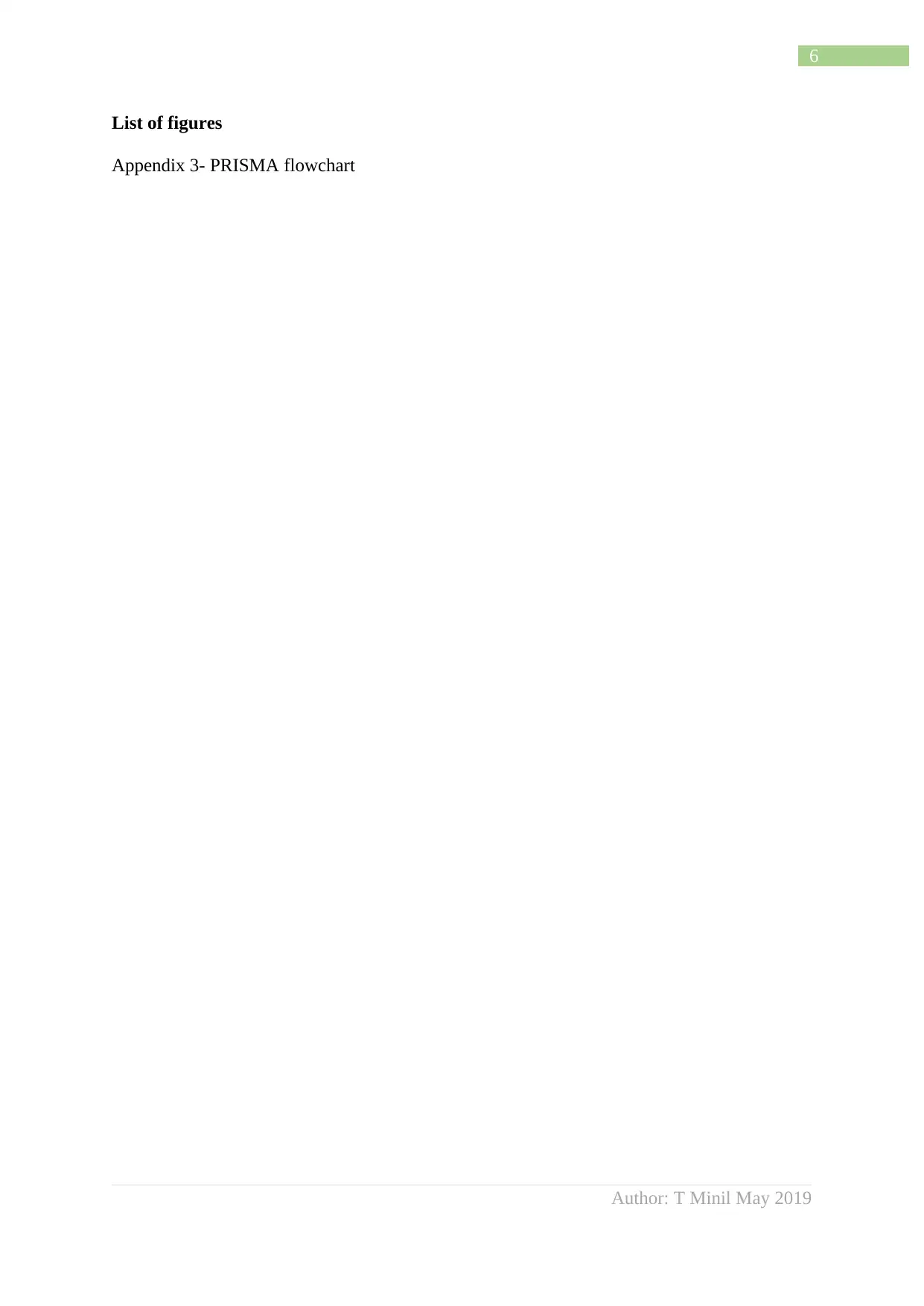
6
List of figures
Appendix 3- PRISMA flowchart
Author: T Minil May 2019
List of figures
Appendix 3- PRISMA flowchart
Author: T Minil May 2019
Paraphrase This Document
Need a fresh take? Get an instant paraphrase of this document with our AI Paraphraser
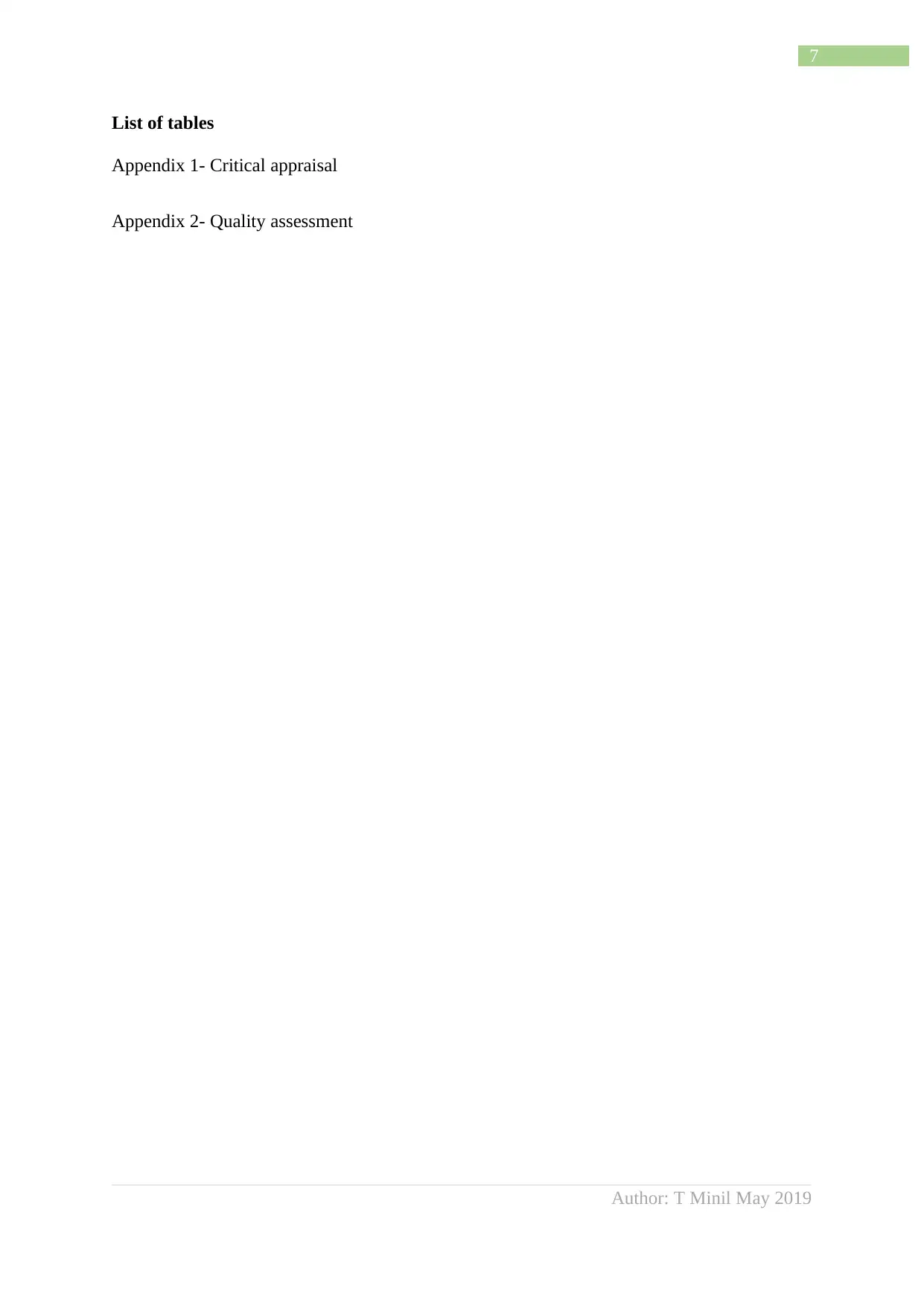
7
List of tables
Appendix 1- Critical appraisal
Appendix 2- Quality assessment
Author: T Minil May 2019
List of tables
Appendix 1- Critical appraisal
Appendix 2- Quality assessment
Author: T Minil May 2019

8
List of appendices
Appendix 1- Critical appraisal
Appendix 2- Quality assessment
Author: T Minil May 2019
List of appendices
Appendix 1- Critical appraisal
Appendix 2- Quality assessment
Author: T Minil May 2019
⊘ This is a preview!⊘
Do you want full access?
Subscribe today to unlock all pages.

Trusted by 1+ million students worldwide
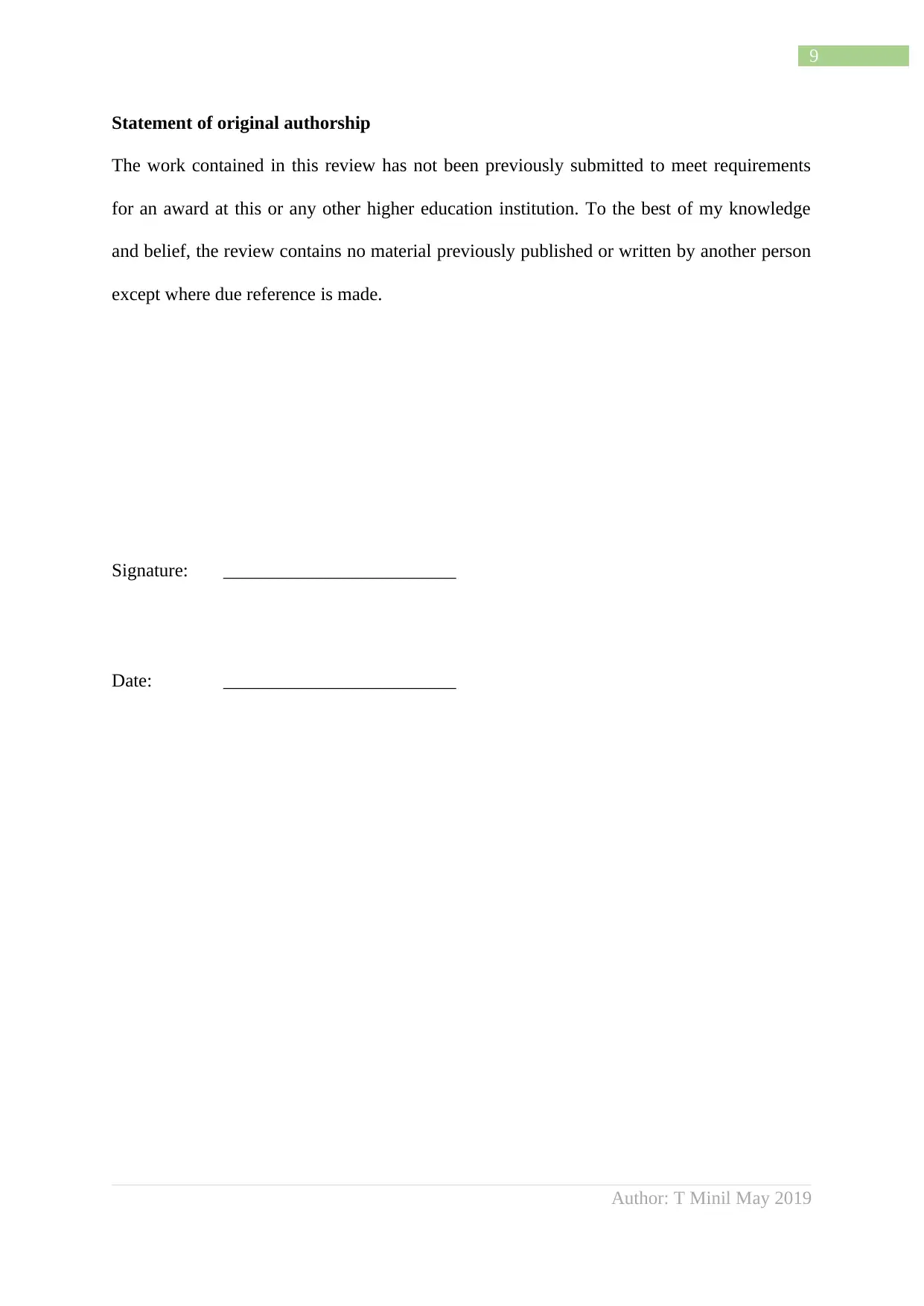
9
Statement of original authorship
The work contained in this review has not been previously submitted to meet requirements
for an award at this or any other higher education institution. To the best of my knowledge
and belief, the review contains no material previously published or written by another person
except where due reference is made.
Signature: _________________________
Date: _________________________
Author: T Minil May 2019
Statement of original authorship
The work contained in this review has not been previously submitted to meet requirements
for an award at this or any other higher education institution. To the best of my knowledge
and belief, the review contains no material previously published or written by another person
except where due reference is made.
Signature: _________________________
Date: _________________________
Author: T Minil May 2019
Paraphrase This Document
Need a fresh take? Get an instant paraphrase of this document with our AI Paraphraser
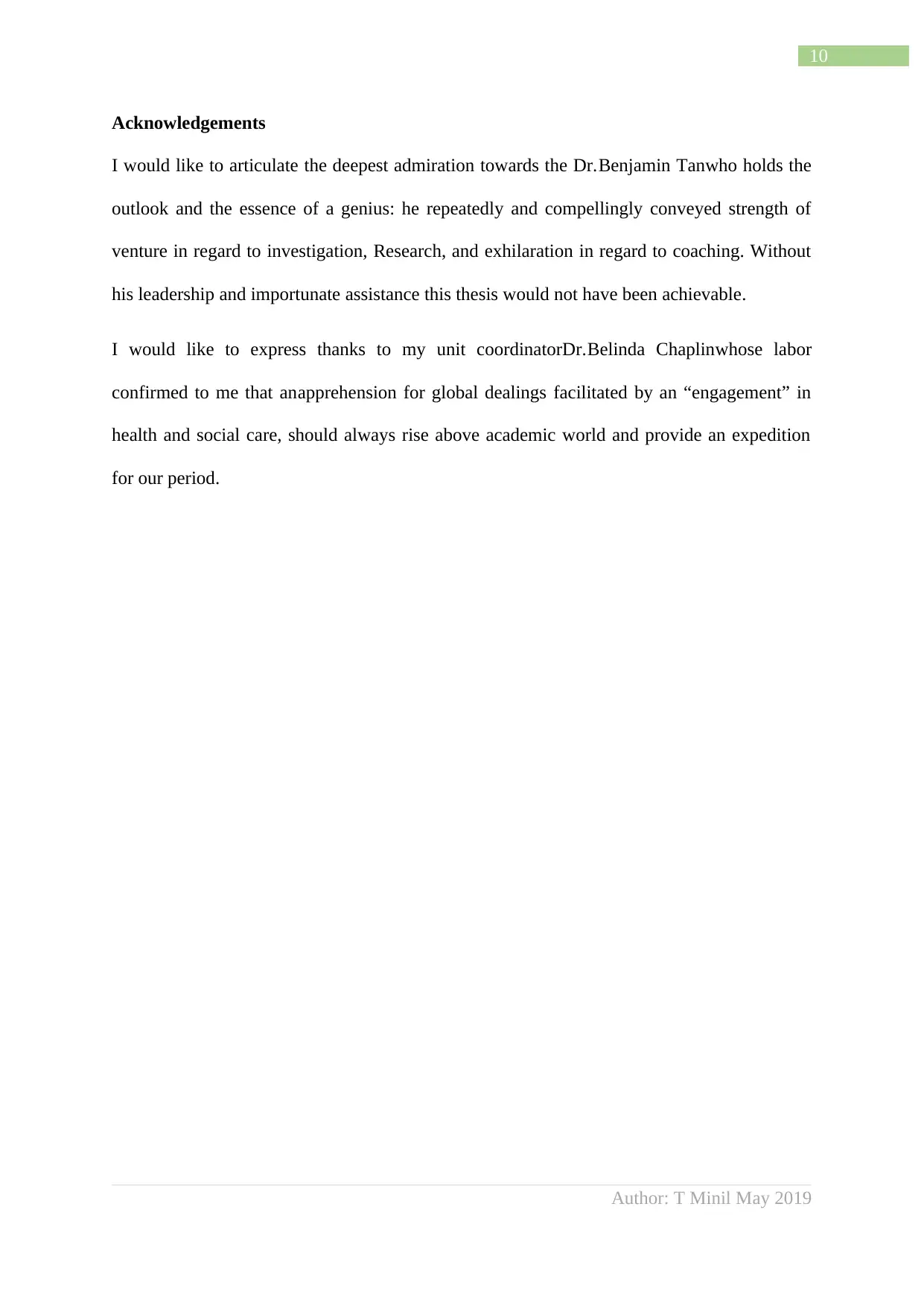
10
Acknowledgements
I would like to articulate the deepest admiration towards the Dr.Benjamin Tanwho holds the
outlook and the essence of a genius: he repeatedly and compellingly conveyed strength of
venture in regard to investigation, Research, and exhilaration in regard to coaching. Without
his leadership and importunate assistance this thesis would not have been achievable.
I would like to express thanks to my unit coordinatorDr.Belinda Chaplinwhose labor
confirmed to me that anapprehension for global dealings facilitated by an “engagement” in
health and social care, should always rise above academic world and provide an expedition
for our period.
Author: T Minil May 2019
Acknowledgements
I would like to articulate the deepest admiration towards the Dr.Benjamin Tanwho holds the
outlook and the essence of a genius: he repeatedly and compellingly conveyed strength of
venture in regard to investigation, Research, and exhilaration in regard to coaching. Without
his leadership and importunate assistance this thesis would not have been achievable.
I would like to express thanks to my unit coordinatorDr.Belinda Chaplinwhose labor
confirmed to me that anapprehension for global dealings facilitated by an “engagement” in
health and social care, should always rise above academic world and provide an expedition
for our period.
Author: T Minil May 2019
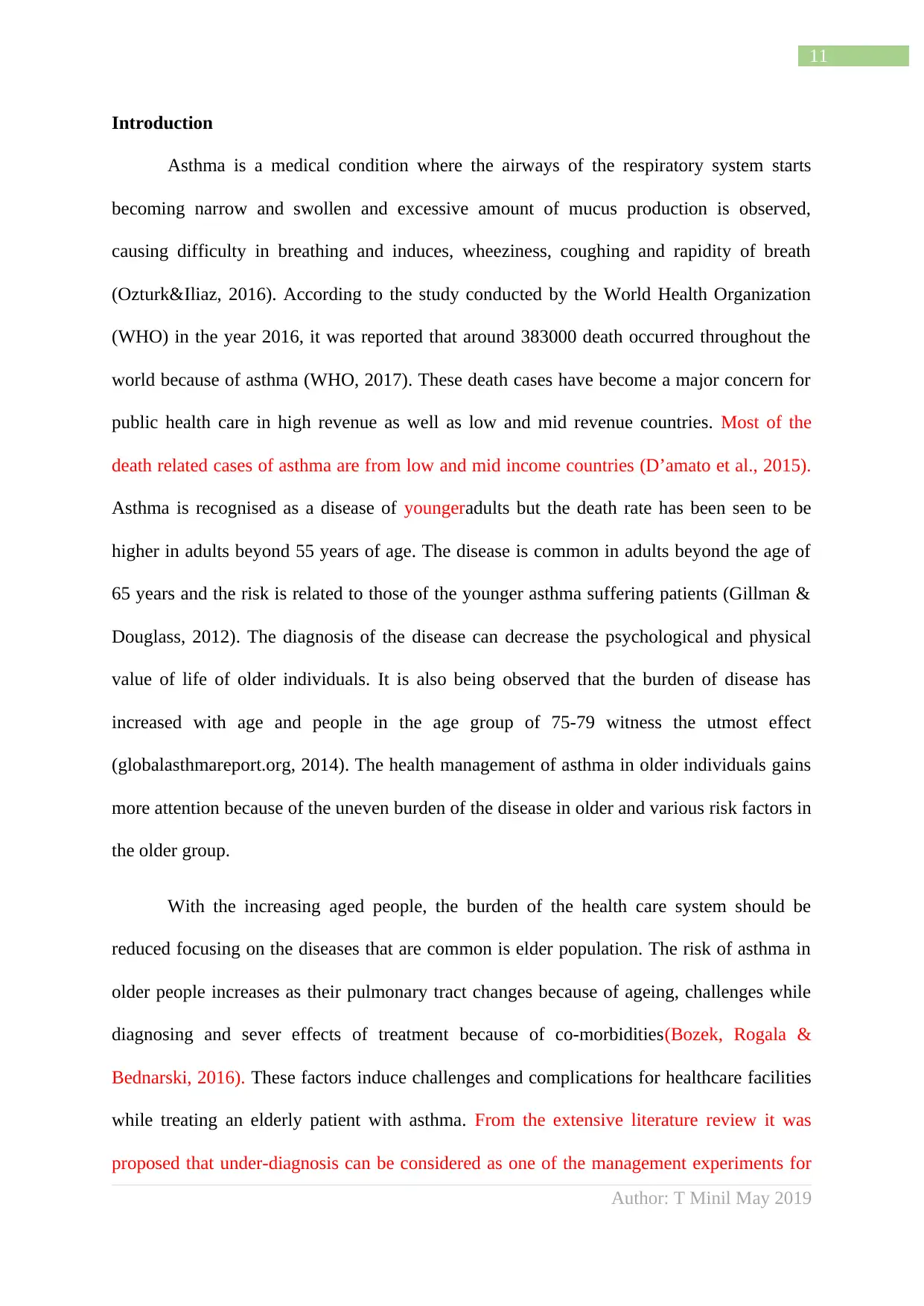
11
Introduction
Asthma is a medical condition where the airways of the respiratory system starts
becoming narrow and swollen and excessive amount of mucus production is observed,
causing difficulty in breathing and induces, wheeziness, coughing and rapidity of breath
(Ozturk&Iliaz, 2016). According to the study conducted by the World Health Organization
(WHO) in the year 2016, it was reported that around 383000 death occurred throughout the
world because of asthma (WHO, 2017). These death cases have become a major concern for
public health care in high revenue as well as low and mid revenue countries. Most of the
death related cases of asthma are from low and mid income countries (D’amato et al., 2015).
Asthma is recognised as a disease of youngeradults but the death rate has been seen to be
higher in adults beyond 55 years of age. The disease is common in adults beyond the age of
65 years and the risk is related to those of the younger asthma suffering patients (Gillman &
Douglass, 2012). The diagnosis of the disease can decrease the psychological and physical
value of life of older individuals. It is also being observed that the burden of disease has
increased with age and people in the age group of 75-79 witness the utmost effect
(globalasthmareport.org, 2014). The health management of asthma in older individuals gains
more attention because of the uneven burden of the disease in older and various risk factors in
the older group.
With the increasing aged people, the burden of the health care system should be
reduced focusing on the diseases that are common is elder population. The risk of asthma in
older people increases as their pulmonary tract changes because of ageing, challenges while
diagnosing and sever effects of treatment because of co-morbidities(Bozek, Rogala &
Bednarski, 2016). These factors induce challenges and complications for healthcare facilities
while treating an elderly patient with asthma. From the extensive literature review it was
proposed that under-diagnosis can be considered as one of the management experiments for
Author: T Minil May 2019
Introduction
Asthma is a medical condition where the airways of the respiratory system starts
becoming narrow and swollen and excessive amount of mucus production is observed,
causing difficulty in breathing and induces, wheeziness, coughing and rapidity of breath
(Ozturk&Iliaz, 2016). According to the study conducted by the World Health Organization
(WHO) in the year 2016, it was reported that around 383000 death occurred throughout the
world because of asthma (WHO, 2017). These death cases have become a major concern for
public health care in high revenue as well as low and mid revenue countries. Most of the
death related cases of asthma are from low and mid income countries (D’amato et al., 2015).
Asthma is recognised as a disease of youngeradults but the death rate has been seen to be
higher in adults beyond 55 years of age. The disease is common in adults beyond the age of
65 years and the risk is related to those of the younger asthma suffering patients (Gillman &
Douglass, 2012). The diagnosis of the disease can decrease the psychological and physical
value of life of older individuals. It is also being observed that the burden of disease has
increased with age and people in the age group of 75-79 witness the utmost effect
(globalasthmareport.org, 2014). The health management of asthma in older individuals gains
more attention because of the uneven burden of the disease in older and various risk factors in
the older group.
With the increasing aged people, the burden of the health care system should be
reduced focusing on the diseases that are common is elder population. The risk of asthma in
older people increases as their pulmonary tract changes because of ageing, challenges while
diagnosing and sever effects of treatment because of co-morbidities(Bozek, Rogala &
Bednarski, 2016). These factors induce challenges and complications for healthcare facilities
while treating an elderly patient with asthma. From the extensive literature review it was
proposed that under-diagnosis can be considered as one of the management experiments for
Author: T Minil May 2019
⊘ This is a preview!⊘
Do you want full access?
Subscribe today to unlock all pages.

Trusted by 1+ million students worldwide
1 out of 73
Related Documents
Your All-in-One AI-Powered Toolkit for Academic Success.
+13062052269
info@desklib.com
Available 24*7 on WhatsApp / Email
![[object Object]](/_next/static/media/star-bottom.7253800d.svg)
Unlock your academic potential
Copyright © 2020–2025 A2Z Services. All Rights Reserved. Developed and managed by ZUCOL.





